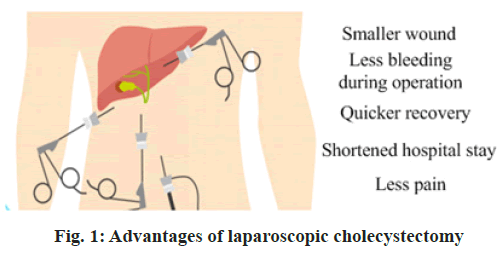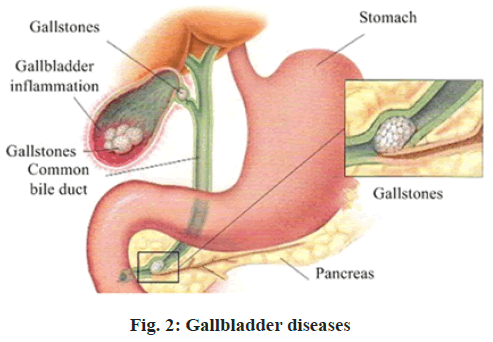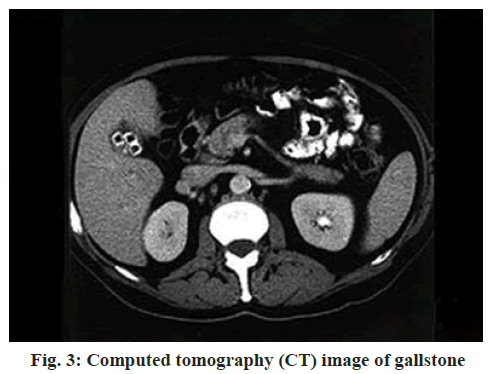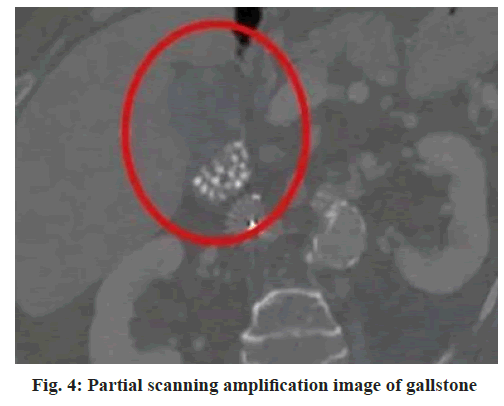- *Corresponding Author:
- Ging Yang
Department of Anesthesiology
Zhangjiakou First Hospital
Zhangjiakou City 075000
China
E-mail: zjj1391345@163.com
| This article was originally published in Special issue, “Trends in Therapeutic Management of Various Clinical Conditions-II” |
| Indian J Pharm Sci 2021:83(2)Spl issue;122-125 |
This is an open access article distributed under the terms of the Creative Commons Attribution-NonCommercial-ShareAlike 3.0 License, which allows others to remix, tweak, and build upon the work non-commercially, as long as the author is credited and the new creations are licensed under the identical terms
Abstract
To compare the elderly patients stress responses to laparoscopic cholecystectomy between using general anesthesia and using general anesthesia combined with epidural anesthesia. Elderly patients who had been treated with laparoscopic cholecystectomy in our hospital from June 2014 to June 2016 were randomly divided into two groups according to the difference of anesthesia. The observation group contained 130 patients who were applied with general anesthesia combined with epidural anesthesia, while the control group contained 100 patients given with general anesthesia only. By detail recording of the variations of blood glucose, cortisol, C-reactive protein in peripheral blood at different stages and comparing indexes such as heart rate, blood pressure, mean arterial pressure of both groups, the stress responses of patients between two different anesthetic methods were evaluated. During operation and after extubation, the blood glucose and C-reactive protein of both group were higher than those before operation and the comparison was of statistical significance, p<0.05, the blood glucose, cortisol and C-reaction protein of observation group was lower than those of control group, with statistical significance, p<0.05. The difference in heart rate, blood pressure and mean arterial pressure between two groups was of no statistical significance, p>0.05. Compared with general anesthesia, the general anesthesia combined with epidural anesthesia can cause lower stress response of elderly patients, which is safer and more reliable and worthy of being promoted in clinical application.
Keywords
Laparoscopic cholecystectomy, elderly patients, stress response, general anesthesia, general anesthesia combined with epidural anesthesia
As a newly emerging minimally invasive surgery method in recent years, laparoscopic cholecystectomy is one of major treatment methods for gallbladder disease in clinics, which has advantages including small wounds, less pain, quick recovery, shortened hospital stay and less bleeding. Therefore, many elderly patients with gallbladder disease prefer laparoscopic cholecystectomy to guarantee their life health and safety[1] (fig. 1). However, clinical experiences show that the operation length of laparoscopic cholecystectomy is difficult to estimate and if the disease condition is special, it needs to turn to laparotomy, which will increase the difficulty and risk of the operation in certain degree[2]. In addition, compared with conventional laparotomy, laparoscopic cholecystectomy entails more strict requirements on postoperative indications and contraindication which should be attached with special attention, especially for elderly patients[3,4]. All these issues increase the difficulty for anesthesia in laparoscopic cholecystectomy. Relevant documents show that during operating laparoscopic cholecystectomy, carbon dioxide pneumoperitoneum pressure may affect the hemodynamic indexes of patients[5]. Elderly patients have gradually decreasing physical function and organ function, therefore the surgery anesthesia may cause bigger impact for them. The research of Wu Jiangming, Wang Dong et al.[6] points out that elderly patients have poorer myocardial viscoelasticity and gradually show the problem of angiosclerosis. Therefore, the cardiovascular system of elderly patients is of lower compliance and thus circulatory function may be affected in certain degree. After surgery and anesthesia, elderly patients are more likely to show stress responses. In certain severe condition, it will increase surgical risk, making negative impact on patient’s life health and safety[7-11]. Therefore, during conducting laparoscopic cholecystectomy for elderly patients, it needs to adopt a more reliable way of anesthesia to increase the surgery safety.
In this paper, the anesthetic effects of 230 patients who has been given with different anesthetic methods were researched, which indicated that the epidural anesthesia combined with general anesthesia created smaller stress response, which was a relative way of anesthesia. In this research, 230 patients who had been treated with laparoscopic cholecystectomy in our hospital from June 2014 to June 2016 were selected as research objects. The observation group contained 130 patients, applied with epidural anesthesia combined with general anesthesia, including 76 male patients, 54 female patients, with average age at (68.5±4.2) y old and average weight at (57.5±3.2) kg; The control group contained 100 patients, applied with general anesthesia, including 59 male patients, 41 female patients, with average age at (69.4±3.5) y old and average weight at (56.8±3.6) kg. The comparison between two groups showed no statistic difference (p>0.05), indicating that the result was reliable. Inclusion and exclusion criteria[12]: All patients selected in this research were subjected to imageological and laboratory examination as shown in fig. 2-4. They were over 60 y old, knew the purpose and significance of the research and signed informed consent forms. This research gained the signature and approval of ethics committee. Those with serious liver, kidney, cardiovascular disease, nervous system disease, or history of smoking and alcohol were excluded in this research.
Within 30 min before operation, all patients were given with intramuscular injection of atropine by dosage of 0.5 mg (Manufacturer: Zhejiang Ruixin Pharmaceutical Co., ltd. Approval number: State Medicine H33020465); of phenobarbital sodium by dosage of 100 mg (Manufacturer: Tianjin Jinyao Pharmaceutical Co., ltd. Approval number: State Medicine H1020381); After pushing into operation room, the peripheral veins of patients were cut through and intravenous injection of midazolam was given by dosage of 0.05 mg/kg (Manufacturer: Zhejiang Ruixin Pharmaceutical Co., LTD. Approval number: State Medicine H10980025). The patients in observation group were given with epidural anesthesia combined with general anesthesia by inserting an epidural tube at T8-9 clearance puncture into 3-4 cm depth and by injecting 3 ml of 2 % lidocaine (Manufacturer: Jincheng Haisi Pharmaceutical Co., ltd. Approval number: State Medicine H14023559) till the emergence of level of anesthesia. After that, make sure there was no total spinal anesthesia and then conduct anesthesia induction. The induction drug and parameters were the same with those of control group. After tracheal intubation, inject into epidural space with 5 % Ropivacaine mesylate (Manufacturer: Chenxin Pharmaceutical Co., ltd. Approval number: State Medicine H20061064) and 7 ml of lidocaine (Manufacturer: Jincheng Haisi Pharmaceutical Co., ltd. Approval number: State Medicine H14023559). The patients in control group were given with general anesthesia by intravenous injection of sufentanil (Manufacturer: Yichang Renfu Pharmaceutical Co., ltd. Approval number: State Medicine H20054172), propofol (Manufacturer: Fresenius Kabi AB. Approval number: State Medicine J20080023). After intubation, perform mechanical ventilation for patients, by ventilation volume of 8-10 ml/kg and keep respiratory rate at 12 times/min. Maintain general anesthesia by pumping into 15-30 ml/h propofol (Manufacturer: Fresenius Kabi AB. Approval number: State Medicine J20080023) and 15-30 μg/h sufentanil (Manufacturer: Yichang Renfu Pharmaceutical Co., ltd. Approval number: State Medicine H20054172) and keep muscle relaxed by intermittent intravenous injection of vecuronium bromide (Manufacturer: Zhejiang Xianju Pharmaceutical Co., ltd. Approval number: State Medicine H19991172). Compare blood glucose (Glu), cortisol (Cor), C-reactive protein level (CRP), heart rate (HR), blood pressure (BP), mean arterial pressure (MAP) of two groups at different stages, such as before anesthesia, after intubation, 30 min during operation and after extubation. This paper presents research on the difference of elderly patients stress reaction to laparoscopic cholecystectomy caused by two different anesthetic methods. SPSS 21.0 software was adopted to process and analyze experiment data, wherein measurement data was expressed in (±s) and tested by t. Only when p<0.05 was met, the intergroup difference will be statistically significant. The Glu and CRP level of both groups during operation and after extubation were significantly higher than those before operation, p<0.05, with statistical significance. The Glu, Cor and CRP level of observation group during operation and after extubation were lower than those of control group, p<0.05, with statistical significance. Detailed data is shown in Table 1-3 below. The HR, BP, MAP of both groups at different stages are shown in Table 4 below, without statistical difference (p>0.05). Through comparing Glu, Cor, CPR level and multiple hemodynamic indexes, this paper analyzed the stress reactions of elderly patients to laparoscopic cholecystectomy between general anesthesia and general anesthesia combined with epidural anesthesia. As parahormone produced by adrenal gland upon stress reaction, Glu level is changed by stress reactions such as major surgery and fracture trauma. Cor level can reflect the level of human stress level. CRP is an acute phase protein synthesized by liver. In response to occurrence of infection or inflammatory reaction of tissue, CPR is quickly produced upon the stimulation of cytokines, which can be regarded as an effective marker of surgical stress response. According to research results, relevant indexes of both groups before anesthesia, after intubation and after pneumoperitoneum are of no statistical difference. However, from the intraoperative stage of 30 min, the difference of indexes emerges and maintain after extubation. The variation of indexes of observation group is relatively stable, which is significantly advantageous over control group (p<0.05). In addition, haemodynamics examination results show that all haemodynamic indexes of both groups at various stages are of no statistical difference (p>0.05), indicating that the two anesthetic methods exert no significant effect on the hemodynamic indexes of patients. In conclusion, this research fully demonstrates that epidural anesthesia combined with general anesthesia cause smaller stress response to laparoscopic cholecystectomy of elderly patients as compared with general anesthesia. The epidural anesthesia combined with general anesthesia is safer and can effectively guarantee life safety of elderly patients, which is worthy of being widely promoted in clinical practices.
| Group | Before anesthesia | 30 min during operation | After extubation |
|---|---|---|---|
| Observation group (130) | 4.16±0.72 | 4.75±0.41 | 5.12±0.35 |
| Control group (100) | 4.18±0.69 | 6.52±0.58 | 6.78±0.55 |
| t | 0.213 | 27.096 | 27.860 |
| p | 0.832 | 0.000 | 0.0000 |
Table 1: GLU Indexes of Both Groups at Different Stages [(x?±s), mmol/L]
| Group | Before anesthesia | 30 min during operation | After extubation |
|---|---|---|---|
| Observation group (130) | 213.55±87.74 | 172.45±95.32 | 192.17±96.58 |
| Control group (100) | 212.42±89.67 | 267.52±100.25 | 257.25±108.52 |
| t | 0.096 | 8.025 | 4.799 |
| p | 0.924 | 0.000 | 0.000 |
Table 2: COR Indexes of Both Groups at Different Stages [(x?±s), mmol/L]
Conflicts of Interest:
The authors declared no conflict of interest.
| Group | Before anesthesia | 30 min during operation | After extubation |
|---|---|---|---|
| Observation group (130) | 15.75±6.48 | 65.23±21.45 | 74.56±16.35 |
| Control group (100) | 14.78±6.32 | 97.42±26.35 | 105.58±18.75 |
| t | 1.136 | 10.210 | 13.378 |
| p | 0.257 | 0.000 | 0.000 |
Table 3: CRP Levels of Both Groups at Different Stages [(x?±s), mg/L]
| Contents | Before anesthesia | 30 min during operation | After extubation |
|---|---|---|---|
| HR (time/min) | |||
| Observation group (130) | 78.8±10.9 | 86.5±8.7 | 79.5±14.5 |
| Control group (100) | 79.1±11.2 | 87.3±8.9 | 80.6±13.8 |
| Systolic BP (kPa) | |||
| Observation group (130) | 17.6±2.7 | 17.6±2.8 | 17.4±2.2 |
| Control group (100) | 17.4±2.9 | 17.7±2.4 | 17.2±2.5 |
| Diastolic BP (kPa) | |||
| Observation group (130) | 10.8±1.4 | 12.2±2.3 | 12.7±2.1 |
| Control group (100) | 10.7±1.6 | 12.4±2.4 | 12.6±1.9 |
| MAP (kPa) | |||
| Observation group (130) | 13.5±1.4 | 13.3±1.5 | 13.5±1.6 |
| Control group (100) | 13.4±1.2 | 13.1±1.7 | 13.1±1.5 |
Note: Intergroup difference of each item was of no statistical significance, p>0.05
Table 4: Hemodynamic Indexes of Both Groups at Different Stages (x?±s)
References
- Zhang J. Effects of two anesthetic methods on elderly patients stress responses to laparoscopic cholecystectomy. China Commun Doct 2010;12(22):66-7.
- Huang G, Chen H, Wang Q, Hong X, Hu P, Xiao M, et al. High platelet-to-lymphocyte ratio are associated with post-stroke depression. J Affect Disord 2019;246:105-11.
- Liang Y. Influence on hemodynamics in elderly patients with laparoscopic cholecystectomy by target controlled infusion of propofol combined with remifentanil. Med Innov China 2016;13(25):133-6.
- Jiang YD, Zhao SM. Effect of remifentanil combined with propofol anesthesia on stress response and blood gas index in patients with laparoscopic cholecystectomy. J Hainan Med Univ 2016,22(7):677-82.
- Kuang T. Influence of different anesthesia on physiological responses in the elders accepting laparoscopic cholecystectomy. Mod Diagn Treat 2012;23(1):22-3.
- Wu CJ, Qian P. Effect of propofol-sufentanyl on stress response and haemodynamics of elderly patient under laparoscopic cholecystectomy. J Hainan Med Coll 2014;20(2):273-5.
- Pan HJ. Hemodynamics and stress response change with different anesthesia for laparoscopic cholecystectomy in elderly patients. China Mod Doct 2011;49(18):142-3.
- Han YX, Chen AD, Liu PY. Effects of two anaesthesia methods on stress reaction in old patients undergoing laparoscopic cholecystectomy. J Clina Res 2009;26(2):302-4.
- Li XR, Li YX, Du SF, Sun YH. Ephedrine relieving cardiovascular response of elderly patients under anesthesia induction with propofol. J Med Forum 2004;25(3):11-3.
- Wang T, Cheng ZX, Meng JH. Effect of different anesthesia methods on perioperative stress response in patients with laparoscopic cholecystectomy. J Ningxia Med Univ 2014;36(10):1104-6.
- Gong H. Effect of different anesthesia on stress reaction of elderly laparoscopic cholecystectomy. China Mod Doct 2013;51(32):109-11.
- Liu RW. Influence of sufentanil and fentanyl used for anaesthesia on hemodynamics in elderly patients with laparoscopic cholecystectomy. China Mod Med 2018;25(3):67-9.








